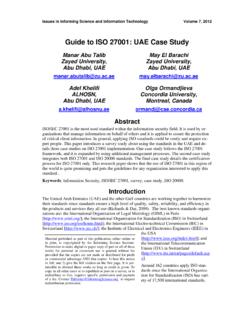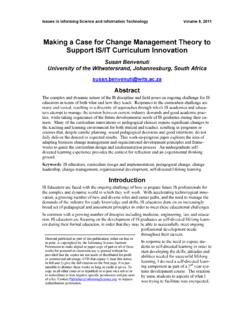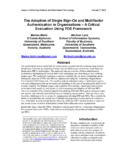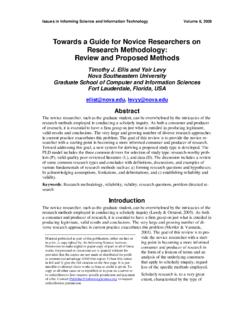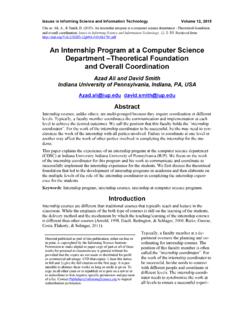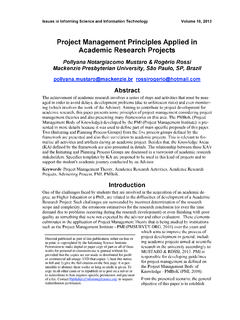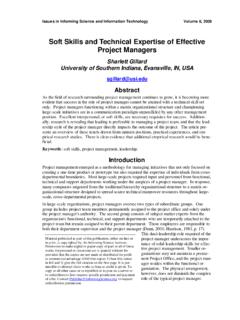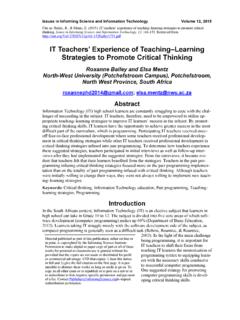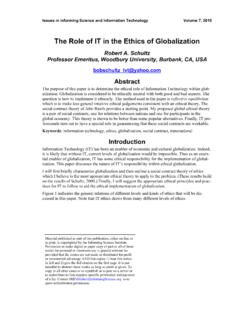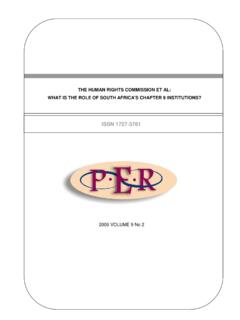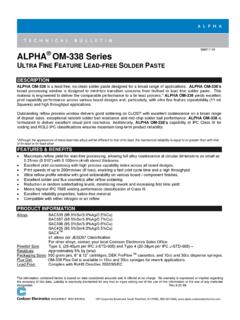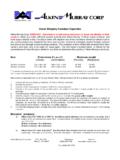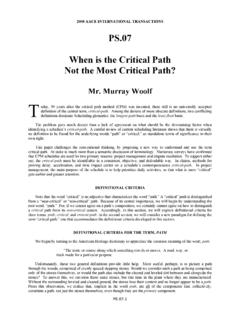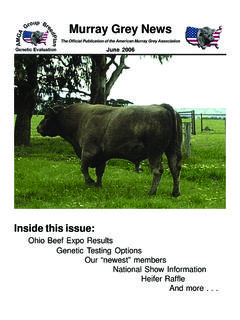Transcription of Animated Courseware Support for Teaching …
1 Issue s in Informing Science and Information Technology Volume 6, 2009 Animated Courseware Support for Teaching database Design Meg murray and Mario Guimaraes Kennesaw State University, Kennesaw, GA, USA Abstract database technologies are a core component of computing technology curricula. Their impor-tance will only continue to expand as more and more data are retained in database systems. An effective database system is predicated on a good data model. database design is the conceptu-alization of an underlying data mode l that progresses from identifying user requirements to graphica lly depicting those requirements and fina lly mapping the graphical models to a set of ta-bles implemented in a phys ical database system. The abstract nature of much of database design makes it challenging to teach. This paper presents a set of software animations designed to sup-port the Teaching of database design concepts. Topic areas covered include mapping problem descriptions to Entity Relationship (ER) diagrams, mapping ER diagrams to tables, normalization and denormalization and comparison of various ER notation sets.
2 The animations are fairly intui-tive to use and are independent of any specific database text or product. They are intended to provide supplementa l instructiona l Support and a lso provide students with additiona l learning op-portunities. Ke ywords: database , database design, entity re lationship diagrams, norma lization, database soft-ware animations. Introduction database technologies are foundationa l to effective information systems and an effective database system is predicated on a good data model. The goal of database design is to conceptualize an underlying data model and determine an appropriate structure to be used in the phys ical imple-mentation of that mode l. Consequently, understanding database design is central to understanding a good data model and an effective database implementation. However, the abstract nature of da-tabase design can make it challenging to teach and challenging to learn (Chilton, McHaney, & Chae, 2006). One way to address this challenge is through the use of supplementa l instructiona l materials.
3 We are developing a set of software animations to Support the Teaching of database de-sign as well as other database related concepts. The animations are part of a larger Animated data-base Courseware project funded through a Nationa l Science Foundation Course, Curriculum and Laboratory Improve-ment grant. The Courseware is freely available and can be accessed at Animations and visua lizations have been touted as a means to provide addi-tional instructional Support to convey complex and dynamic topics especially when commonly used Teaching method-M aterial p ublished as p art of this p ublication, either on-lin e or in p rint, is copy righted by the Informing Scien ce Institute. Permission to make digital or p ap er copy of p art or all of these works for p ersonal or classroom use is granted without fee p rovided that the cop ies are not made or distributed for p rofit or commer cial advantage AND that cop ies 1) bear this notice in full and 2) give the full citation on the first p age.
4 It is p er-missible to abstract these works so long as cred it is giv en. To copy in all other cases or to rep ublish or to p ost on a server or to redistribute to lists requires sp ecific p ermission and p ay ment of a fee. Contact Publisher@Informin g to request redistribution p ermission. Animated Courseware Support 202 ologies such as lectures and textbooks do not appear to be sufficient. Animations have been used in many disciplines, including computer science, where animations exist to Support the Teaching of algorithms, machine execution, networking and programming. While the achievement of learn-ing outcomes as a result of using animations has been mixed, there is evidence that animations do Support the Teaching and learning process. Animations have been found to increase student moti-vation and visualizations have been found to help students develop understanding of abstract con-cepts which are otherwise considered to be invis ible (Steinke, Huk, & Floto, 2003).
5 In their study of ways to introduce the idea of pervasive computing to students, Woodcock, Burns, Mount, Newman, and Gaura (2005) cite that using words and pictures helped students construct verbal and pictoria l menta l mode ls as well as to build connections between them and increased their ability to understand the precepts of the topic under study. Further, Mayer (2001) notes that the capacity of animations to portray information in a different way engages the use of an addi-tional cognitive channel, thereby, reducing the learner s overall cognitive load. Whatever the case, providing multiple venues of learning Support such as supplemental instructional materials does contribute to heightened levels of student learning. A review of the literature revealed very few animations or visua lized tutorials that Support the Teaching of database concepts. A majority of these programs focus specifically on some aspect of SQL or query execution. For instance, W3 Schools (W3 Schools , 2009) offers an interactive SQL tutorial and A llenstein, Yost, Wagner and Morrison (2008) provide a simulation system to enable students to visua lize the steps required to execute a database query.
6 The WINRDBI Educational Tool developed at Arizona State University (WINRDBI Educational Tool, ) provides an in-terpreter that allows students to program in interactive SQL, relational a lgebra, domain calculus or tuple calculus. While several drawing tools are available that provide Support for the mechani-cal creation of ER diagrams, no Animated instructional Support materia ls were found that that ad-dress the topic of database design. The process of database design includes identifying user requirements, conceptualizing those re-quirements into a graphical data mode l, mapping that model into a physica l database system and assessing the mode l to insure data anomalies are reduced, data integrity ma inta ined and data re-dundancy eliminated, a process known as normalization. The animations inc luded for database design in the Animated database Courseware (ADbC) project follow this process for the devel-opment of a relational database system. Specifically they inc lude sub-modules for mapping sce-narios to data models us ing Entity-Relationship (ER) Diagrams, converting ER diagrams to tables and normalization and denormalization.
7 They also inc lude a sub-module demonstrating various ER notation sets. In this paper, each of these modules will be discussed inc luding a short discus-sion of the design princ iple, the purpose of the animations and how they might be utilized in the classroom. ER Notation Sets An Entity-Re lationship (ER) Diagram is a conceptual representation of data and their relation-ships. ER diagrams depict the organization of data into thematically characterized entities sup-ported by correlated details referred to as attributes or fie lds and are comprised of four compo-nents, entities, re lationships , attributes and cardina lities. (Although, for simplicity and to avoid clutter, attributes are sometimes not displayed.) Relationships between entities are identified as the cardinality or quantitative minimum or maximum number of instances of an entity that may participate in a relationship. For example, in a typical academic scenario, entities might be organ-ized into students, faculty and courses.
8 Faculty teach courses and students take courses are examples of relationships. Cardina lity defines minimum and maximum participation such as a faculty member may teach from one to many courses. Cardinality is close ly aligned with pre-defined rules. murray & Guimaraes 203 ER Diagrams were first articulated by Peter Chen in 1976 (Chen, 1976) but no standard notation set has been adopted for their creation. This can be confusing as different software designers, da-tabase texts and different software programs use different symbol sets. The purpose of the ER Notation Sets animation is to allow users to quickly associate one notation set with another. The animation consists of seven different relations hips with s ix different notation sets. Relationships inc lude 1-N Binary Non Identifying, 1-N Binary Identifying, N-N Binary, 1-1 Binary, 1-N Unary, Generalization (incomplete, overlap) and Generalization (complete, dis joint). Notation sets de-picted inc lude the Maximum, Minimum/Maximum, Martin (1989) notation (as used in Hoffer, Prescott & Topi, 2008), UML Class and the IDEF1X adopted by the US federal government.
9 Al-so inc luded is the notation used by Kroenke (2006) and Kroenke and Auer (2008) in their many database textbooks. Other notation sets exist but this collection, while including some of the more well-known notation sets, orients students to the non-standardization that exists in symbols em-ployed in ER Diagram mode l development. Figure 1 depicts the ER Notations animation inter-face. Figure 1: ER Notations Animation Inte rface Figure 2 shows a 1-N Binary Non-Identifying Relationship in three different notations : Maxi-mum, Minimum/Maximum, and Martin (from Hoffer, Prescott, & Topi, 2008). It is a binary rela-tionship because there are two entities involved. It is non-identifying as neither entity identifies the other. The numbers on each side of the relationship indicate cardina lity. Note that when there is only one number on each side, it always refers to maximum cardinality. According to the dia-grams in Figure 2, an Employee may belong to a maximum of one Department and a Department may have a maximum of many Employees.
10 The minimum and maximum notation is a more com-plete description of the relationship, but also more complex. It reads, an employee may not work in any Department (zero) and may work in at most one department. A department has at least one employee (1) and may have many employees (N). Students often benefit from reviewing the maximum notation first followed by the minimum/maximum groupings. Also inc luded in this figure is the Martin notation which utilizes crow s feet to depict cardina lity. The oval corre-sponds to optiona l, the hashmark to one or mandatory and the crowfoot to many. It is easy to ex-pla in this notation, when it is compared side-by-side with the Minimum/Maximum notation. Animated Courseware Support 204 Figure 2: Example One-to-Many Binary Re lations hip us ing Three Diffe re nt Notations Figure 3 demonstrates the same relationship us ing three different notation sets. IDEF1X uses the dashed line to distinguis h a one-to-many non-identifying re lationship.
